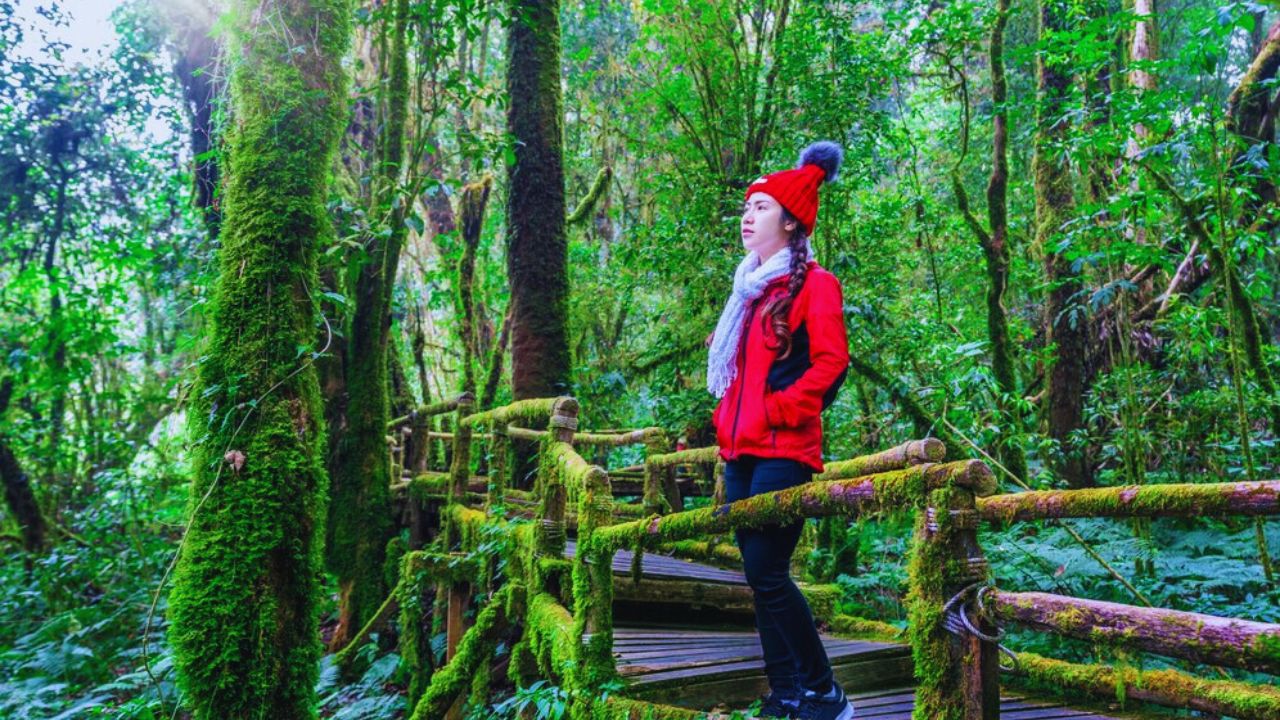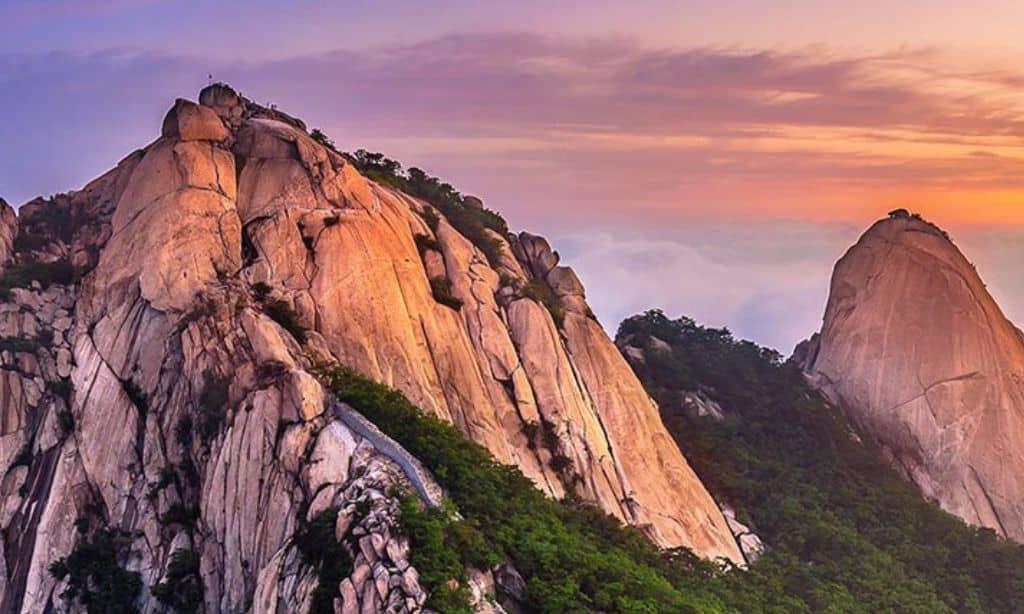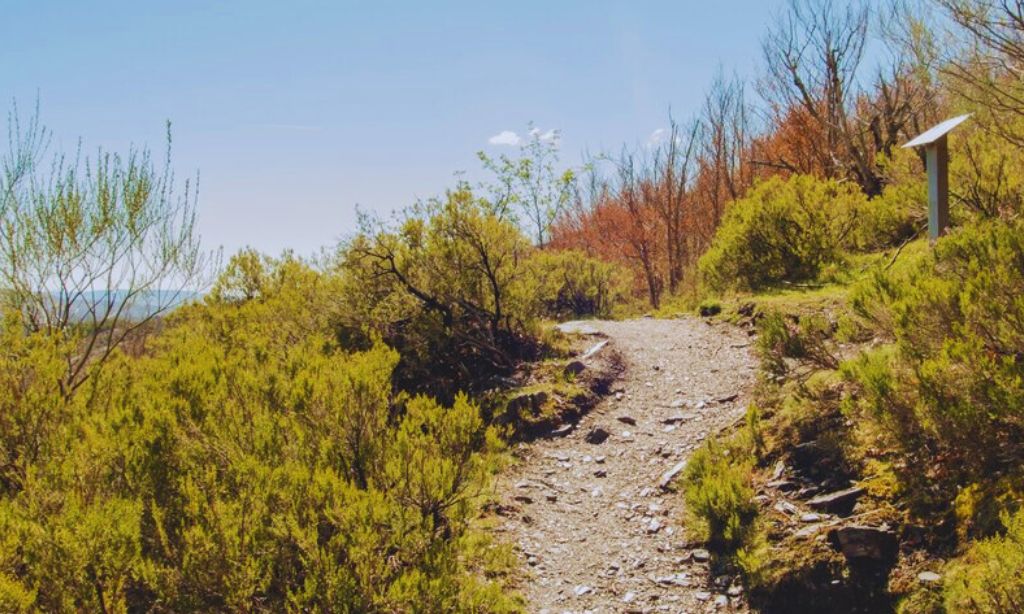South Korea is a paradise for hiking enthusiasts, boasting a diverse array of trails that showcase the country’s stunning natural landscapes. From towering mountain peaks and lush forests to serene coastal paths, South Korea offers something for every type of hiker. Whether you’re an experienced trekker or a casual walker, these five hikes provide an unforgettable way to experience the nation’s natural treasures and unique scenery.
Seoraksan National Park: Majestic Mountain Majesty
Situated in the northeastern region of South Korea, Seoraksan National Park is a premier destination for hikers and nature lovers alike. Approximately a three-hour drive from the bustling capital city of Seoul, Seoraksan is easily accessible yet offers a tranquil escape into nature. The park is renowned for its dramatic granite peaks, diverse flora and fauna, and landscapes that transform with the changing seasons.
Highlight: Daecheongbong Peak
Daecheongbong Peak stands as the third-highest mountain in South Korea, reaching an elevation of 1,708 meters. This peak is the centerpiece of Seoraksan National Park and attracts hikers from all corners of the country. The journey to Daecheongbong is a challenging 15-kilometer trek that includes a steep ascent of approximately 1,500 meters. Hikers are rewarded with panoramic views of the surrounding mountain ranges, dense forests, and cascading waterfalls.
The trail is particularly stunning at sunrise, when the first light of day illuminates the rugged landscape, creating a breathtaking spectacle. Along the way, hikers can explore various points of interest, such as the Sinheungsa Temple, a historic Buddhist temple nestled within the park, and the vibrant autumn foliage that paints the forest in hues of red, orange, and yellow.
Seasonal Beauty
Seoraksan offers a unique experience in every season. In spring, the park is adorned with blooming wildflowers and lush greenery. Summer brings cool mountain air and vibrant ecosystems, while autumn showcases a kaleidoscope of fall colors. Winter transforms Seoraksan into a snowy wonderland, ideal for those who enjoy snow-covered trails and serene landscapes.
Hallasan Mountain on Jeju Island: A Volcanic Challenge
Hallasan Mountain, located on the volcanic island of Jeju, is the highest peak in South Korea, standing at 1,947 meters. This majestic mountain is an extinct volcano and has been designated as a UNESCO World Heritage Site since 2007, recognized for its unique volcanic landscape and rich biodiversity. Hallasan is a symbol of Jeju Island’s natural beauty and cultural significance.
Main Trails: Seongpanak and Gwaneumsa
Hallasan offers two primary trails for hikers: the Seongpanak Trail and the Gwaneumsa Trail. Both trails provide distinct experiences, traversing through diverse landscapes that include dense forests, expansive lava fields, and intriguing volcanic craters.
- Seongpanak Trail: This trail is approximately 9.6 kilometers long and is considered slightly less challenging than the Gwaneumsa Trail. It takes hikers through lush subtropical forests and offers stunning views of the surrounding landscapes. The trail is well-marked and suitable for hikers of varying skill levels.
- Gwaneumsa Trail: Slightly longer at about 8.7 kilometers, the Gwaneumsa Trail is steeper and more demanding. It passes through rugged terrain and offers panoramic views of Hallasan’s unique geological features, including the Baengnokdam Crater.
The Summit Experience
Reaching the summit of Hallasan is a rewarding experience. The Baengnokdam Crater, located at the peak, houses a serene freshwater lake that reflects the surrounding mountains and sky. The summit provides a 360-degree view of Jeju Island, allowing hikers to appreciate the island’s natural beauty from a vantage point. The peaceful atmosphere at the top is perfect for relaxation and reflection after a challenging climb.
Flora and Fauna
Hallasan is home to a rich variety of plant and animal species, many of which are endemic to the region. Hikers may encounter unique flora such as the Hallasan Azalea and diverse fauna including the Jeju pony, which roams freely in the park. The mountain’s diverse ecosystems make it a fascinating destination for nature enthusiasts and biologists alike.
Jirisan National Park: A Legendary Ridge Line Crossing
Jirisan National Park, located in the southern part of South Korea, is the country’s oldest and one of its largest national parks. Spanning over 480 square kilometers, Jirisan is celebrated for its expansive mountain ranges, deep valleys, and rich biodiversity. The park is a sacred place in Korean culture, featuring numerous temples and historical sites nestled within its rugged terrain.
The Jirisan Ridge Line
The Jirisan Ridge Line hike is one of the most challenging and revered trails in South Korea. Covering approximately 40 kilometers, this multi-day trek typically takes two to three days to complete. The trail winds along the ridgeline, offering hikers a diverse array of landscapes, from dense forests and flowing streams to bare rock ridges and precipitous valleys.
Key Highlights
- Cheonwangbong Mountain: Standing at 1,915 meters, Cheonwangbong is the highest peak in Jirisan National Park. The summit is often enveloped in mist, adding an air of mystery and grandeur to the hike. From the top, hikers can enjoy sweeping views of the surrounding mountains and valleys.
- Birobong Peak: Another notable peak along the ridge line, Birobong offers stunning vistas and a sense of accomplishment upon reaching its summit.
- Temples and Cultural Sites: Along the trail, hikers will encounter several historic temples, such as Hwaeomsa Temple, which add a cultural and spiritual dimension to the journey.
Natural Beauty and Wildlife
Jirisan is home to a diverse range of flora and fauna, including rare species such as the Asiatic black bear and the Jirisan deer. The park’s rich biodiversity makes it a vital conservation area and a haven for nature enthusiasts. The changing seasons bring different landscapes to life, from vibrant spring blooms to the fiery colors of autumn foliage.
Jeju Olle Trail: An Unforgettable Coastal Hike
The Jeju Olle Trail is a network of 26 scenic walking paths that circumnavigate Jeju Island, offering hikers a unique way to explore the island’s diverse coastal and inland landscapes. Established to promote sustainable tourism and preserve the island’s natural beauty, the Olle Trail is designed to be accessible to hikers of all levels.
Diverse Landscapes
The Jeju Olle Trail encompasses a wide variety of landscapes, allowing hikers to experience the island’s natural diversity up close. From sandy beaches and towering cliffs to expansive fields and lush green meadows, each trail segment offers something unique. The coastal paths provide stunning views of the East China Sea and the island’s iconic volcanic formations.
Popular Routes
- Route 1: Starting at Gwangchigi Beach, this route features scenic beaches, rolling hills, and picturesque villages. Hikers can enjoy the tranquil seaside atmosphere and explore local markets and cafes along the way.
- Route 7: Known for its dramatic cliffs and rugged coastline, Route 7 offers breathtaking ocean views and opportunities to explore hidden coves and rock formations.
- Route 10: This trail takes hikers through the scenic Jeju countryside, featuring terraced rice fields, traditional farms, and ancient stone walls.
Accessibility and Amenities
One of the key advantages of the Jeju Olle Trail is its accessibility. The trails are well-marked and maintained, making them suitable for hikers of all skill levels. Additionally, the Olle Trail Association provides amenities such as rest areas, restrooms, and accommodations along the routes, ensuring a comfortable and enjoyable hiking experience.
Cultural Experiences
Beyond its natural beauty, the Jeju Olle Trail offers hikers the chance to immerse themselves in Jeju’s unique culture and heritage. Along the trails, visitors can encounter traditional Jeju stone statues, known as dol hareubangs, as well as historic villages and cultural landmarks that reflect the island’s rich history.
Bukhansan National Park: A Beautiful Spectacle on the Outskirts of Seoul
Bukhansan National Park is a green oasis located just a few kilometers from the heart of Seoul, making it an ideal destination for both locals and tourists seeking a quick escape into nature. The park covers an area of approximately 79 square kilometers and features a range of hiking trails that cater to different skill levels.
Popular Trail: Baegundae Peak
Baegundae Peak is the highest point in Bukhansan National Park, standing at 836 meters. The trail to Baegundae is one of the most popular routes, attracting thousands of hikers each year. The ascent is moderately challenging, featuring well-maintained paths, staircases, and scenic viewpoints.
Trail Highlights
- Granite Peaks and Rock Formations: Bukhansan is known for its striking granite peaks and unique rock formations, which provide a dramatic backdrop for hikers.
- Temples and Historical Sites: Along the trail, hikers can visit historic temples such as Doseonsa and Bukhansanseong Fortress, adding a cultural and historical dimension to the hike.
- Panoramic Views of Seoul: From the summit of Baegundae, hikers are treated to spectacular views of Seoul’s sprawling urban landscape juxtaposed against the natural beauty of the surrounding mountains.
Accessibility and Facilities
Bukhansan National Park is easily accessible via Seoul’s extensive metro system, with several access points and trailheads located near major transportation hubs. The park is equipped with various facilities, including rest areas, informational signage, and emergency services, ensuring a safe and convenient hiking experience for all visitors.
Year-Round Attraction
Bukhansan offers a different experience in every season. Spring brings blooming flowers and vibrant greenery, while summer offers cool mountain air and lush landscapes. Autumn showcases brilliant fall colors, and winter transforms the park into a serene, snow-covered retreat
Tips for Hiking in South Korea
Embarking on a hiking adventure in South Korea can be an enriching experience, provided you are well-prepared and informed. Here are some essential tips to ensure a safe and enjoyable hike:
Preparation
- Research Trails: Familiarize yourself with the trail map, difficulty level, and estimated time required for each hike. Understanding the terrain and potential challenges will help you plan effectively.
- Check Weather Conditions: Always check the weather forecast before setting out. South Korea’s weather can be unpredictable, and conditions can change rapidly, especially in mountainous areas.
Gear and Essentials
- Proper Footwear: Invest in high-quality hiking shoes or boots with good grip and support to navigate varied terrains safely.
- Clothing: Dress in layers to adapt to changing weather conditions. Waterproof and windproof jackets are advisable, especially during the rainy season.
- Supplies: Carry essential items such as water, snacks, a map, a compass or GPS device, a first-aid kit, and a flashlight or headlamp.
- Navigation Tools: Ensure you have a reliable map or a fully charged GPS device to stay on course, especially on longer or more remote trails.
Safety and Respect for Nature
- Stay on Marked Trails: To protect the environment and ensure your safety, always follow designated trails and avoid creating new paths.
- Leave No Trace: Adhere to the Leave No Trace principles by packing out all trash, minimizing campfire impacts, and respecting wildlife.
- Emergency Preparedness: Know the location of the nearest medical facilities and have a plan in case of emergencies. Carry a whistle and a portable charger for your phone.
Local Guidelines and Etiquette
- Respect Local Regulations: Follow any posted signs and guidelines specific to the trail or national park. This may include restrictions on camping, fires, and group sizes.
- Cultural Sensitivity: Be mindful of cultural sites and local customs. Show respect when visiting temples and historical landmarks by maintaining a quiet and respectful demeanor.
- Hiking Etiquette: Yield to other hikers on narrow trails, keep noise levels down, and offer assistance to fellow hikers if needed.
Health and Fitness
- Physical Preparation: Ensure you are physically prepared for the hike by engaging in regular exercise and building your stamina, especially for more strenuous trails.
- Hydration and Nutrition: Stay hydrated by drinking plenty of water and maintain your energy levels with nutritious snacks and meals during the hike.
- Pace Yourself: Maintain a steady pace that matches your fitness level, and take regular breaks to rest and enjoy the scenery.
Takeaways
South Korea is a treasure trove for nature lovers and adventure seekers, offering an impressive variety of hiking trails that allow you to fully immerse yourself in its breathtaking natural beauty. From the majestic heights of Seoraksan National Park to the serene coastal trails of Jeju Island, each hike presents its own unique blend of scenic vistas, cultural landmarks, and the opportunity to reconnect with nature. Whether you’re a seasoned hiker looking for a challenge or a casual explorer seeking a peaceful retreat, these top five stunning hikes offer something for everyone.
Beyond the physical journey, these trails provide a deeper connection to South Korea’s rich history and traditions, as many paths wind through ancient temples, sacred sites, and areas of ecological significance. Hiking in South Korea isn’t just about conquering mountains—it’s about experiencing the soul of the land, finding tranquility in its forests, and standing in awe of its sweeping landscapes.
So whether you’re seeking adventure or simply a moment of quiet reflection, these hiking trails promise unforgettable experiences. Lace up your boots, pack your gear, and get ready to explore the awe-inspiring natural beauty that South Korea has to offer. Every step you take on these trails will leave you not only physically rejuvenated but also with memories that will stay with you long after the hike is over.









































